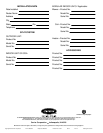
4
control selectors: one for setting the temperature desired during
cooling operation, and one for setting the temperature for heating
operation.
The FAN control offers two options for controlling the blower:
AUTO and ON. When set to AUTO, the blower runs only while the
thermostat operates the cooling or heating equipment. When the
FAN control is set to ON, the blower runs continuously—regardless
of whether the cooling or heating equipment is operating.
Typically, the SYSTEM or MODE control on your thermostat
offers the following selections: COOL, OFF, and HEAT. Your
thermostat may also have a fourth selection: AUTO. Neither the
cooling or heating equipment operate when the SYSTEM or
MODE control is set to OFF. With the SYSTEM or MODE
control set to COOL, your air conditioner will operate when the
indoor temperature rises above the level that you wish to maintain.
With the SYSTEM or MODE control set to HEAT, your furnace
or other heating equipment will operate automatically when the
indoor temperature falls below the level that you have selected.
The AUTO selection found on some thermostats provides for
automatic changeover between cooling and heating modes. With
the SYSTEM or MODE control set to AUTO, your air condi-
tioner will operate when the indoor temperature rises above the
thermostat cooling temperature setting, and your furnace or oth-
er heating equipment will operate when the indoor temperature
drops below the thermostat setting for the heating cycle.
NOTE:
For 2-speed air conditioners, this special feature is built
in to protect the unit:
• 1-MINUTE TIME DELAY – When changing speeds from
low to high, or high to low, there is a 1-minute time delay. During
the speed change delay, the oudoor fan will continue to run.
If you wish to program your accessory electronic indoor ther-
mostat, refer to thermostat Installation Instructions.
Your thermostat may be PROGRAMMABLE or NON-PRO-
GRAMMABLE. A NON-PROGRAMMABLE thermostat does
not allow the temperature settings to be varied throughout the day
or week without physically changing the settings. A PROGRAM-
MABLE thermostat allows various daily temperature changes to
be preset. During the winter, for example, you may wish to “set
back” the temperature of your home at night, then have the tem-
perature return to normal prior to waking up. The home’s temper-
ature can then be lowered again during the day when no one is at
home, but again be at peak comfort level when your family
returns home. During the summer, the opposite changes might be
programmed. When properly used, the programming can result in
energy savings on your home’s heating and cooling.
COOLING MODE
When operating in cooling mode, your air conditioner will run
until the indoor temperature is lowered to the level you have
selected. On extremely hot days, your air conditioner will run
for longer periods at a time and have shorter off periods than on
moderate days.
The following are typical conditions that add extra heat
and/or humidity to your home and force your cooling unit to
work longer to keep your home comfortable:
• Entrance doors are frequently opened and closed.
• Laundry appliances are being operated.
• A shower is running.
• More than the usual number of people are present in the home.
• More than the normal number of electric lights are in use.
• Drapes are open on the sunny side of the home.
HEATING MODE
With the SYSTEM or MODE control of your indoor thermostat
set to HEAT, the furnace or other heating equipment of your
home comfort system will operate until room temperature is
raised to the level you have selected. Of course, the heating
equipment will have to operate for longer periods to maintain a
comfortable environment on cooler days and nights than on
moderate ones.
Refer to your furnace User’s Manual for specific information on
heating operation.
NOTES:
a) Two-speed air conditioners operate for long periods
of time on low speed. This operation improves system efficiency
and your comfort through closer control of temperature and
humidity. Expect longer operating cycles.
b) With two-speed air conditioners, low and high indoor airflow
settings are critical for maintaining system comfort and efficien-
cy. Consult your installer for airflow setting adjustments.
PERFORMING ROUTINE
MAINTENANCE
With the proper maintenance and care, your air conditioner will
operate economically and dependably. Maintenance can be
accomplished easily by referring to the following directions.
MAIN
ON
OFF
Fig. 4—Main Electrical Disconnect
Fig. 5—Removing Filter from
Fan Coil Unit










